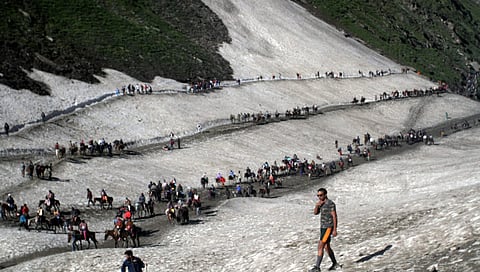Pilgrims’ progress: Faith over fear
One more Terror attack and the bus that fell into a gorge yet again reveal a humongous test of logistics that is the Amarnath pilgrimage

Dubai: According to official estimates, around 40,000 armed and heavily equipped personnel have been pressed into service, apart from the deployment of state-of-the-art surveillance drones and even dog squads, to ensure the safety of some 230,000 visitors who have registered for this year’s annual pilgrimage to the Amarnath shrine — known as Amarnath Yatra in popular parlance in India. Going by the security blueprint, nothing along the two routes to the holy Hindu shrine in Jammu and Kashmir (J&K) — one via Pahalgam and the other through Baltal — is supposed to move even an inch without coming under the radar of the army and the paramilitary forces.
Yet, the threat perception over Amarnath has only grown over the years, as the July 10 terror attack in Khannabal in the Anantnag district, around 8.20pm (local time), on a bus carrying pilgrims bears testimony. But for the incredible bravery and presence of mind displayed by Shaikh Saleem Gafour, driver of the bus from Gujarat — that was ferrying the pilgrims back to Jammu after they had visited the shrine — the death toll could have been much higher than the eight lives that have so far been lost in the dastardly strike.
The question still remains unanswered as to why this vehicle was allowed to venture well into the night, beyond the statutory stoppage time of 5pm? Why was the bus not stopped at any of the six check-points on the highly vulnerable Jhelum corridor of the Pampore-Anantnag highway, before it came under heavy firing from automatic weapons by unidentified assailants?
Or for that matter, take the possibility of accidents on this treacherous terrain. Seventeen pilgrims were killed and at least 30 injured when a bus skidded off and fell into a 100-foot gorge on the Jammu-Srinagar highway at Banihal, in Ramban district of J&K on July 16.
Crisis management
While the union and the state government of Jammu and Kashmir leave no stone unturned to ensure a safe journey to and from the shrine, located in a cave at a height of 12,755 feet above sea level, getting the sheer logistical aspects right, year on year, poses a humongous challenge, apart from battling inclement weather. The growing number of pilgrims, inhospitable terrain and the location of the shrine in one of India’s most geopolitically sensitive areas are parameters that put the administrations’ preparedness and crisis-management skills to the ultimate test — every year.
Consider, for instance, the fact that from June 28, the start date for this year’s pilgrimage, and until the second week of this month, of the estimated 100,000 pilgrims who visited the shrine, only 40,000 had registered themselves with the Amarnath Yatra Board — something that is supposed to be mandatory. Moreover, many of the vehicles that are used to ferry pilgrims are not registered with the board, making them unaccountable in case of any untoward incident. It has been revealed that the bus that was the target of the July 10 terror attack, was not registered and therefore could not be provided with the customary paramilitary escort for vehicles carrying pilgrims.
And in a country of 1.3 billion, the annual pilgrimage to Amarnath is just one of many such public gatherings and movements of people that take place every year. Take, for instance, the annual pilgrimage to Sabarimala. Surrounded by mountains and dense forests in the Western Ghats, the temple in Sabarimala attracts anywhere between 45-50 million people annually. Or for that matter the annual Gangasagar fair in Sagar Islands. These are not just significant for the religious and social connotations they bear, but each of these annual events serve as major signposts in terms of the administrative and logistical challenges they serve up — right from ensuring the safety of the visitors to making clean drinking water accessible to all.
And let us not forget the Mahakumbh or the Kumbh Mela. Taking place once in three years — but at an interval of 12 years at any one of its four designated venues of Haridwar, Allahabad, Ujjain or Nashik — the Kumbh Mela is so huge in terms of participation that there is no clear way of ascertaining as to how many people would actually descend on the venue. According to very rough ballpark figures, around 130 million people were in attendance at the 2013 Kumbh in Allahabad over its two-month duration.
However, keeping in mind the location and the nature of geopolitical contours, there is no denying that among all the major congregations in India, pilgrimage to the Amarnath shrine poses a challenge of a completely different order. And it is truly fascinating that in spite of an ever-growing threat, the number of those ready to risk life and limb has only grown exponentially over time. Until 1990, the average number of pilgrims to Amarnath hovered around 10,000-15,000 annually. This year, an estimated 230,000 will have visited the shrine by the time its 40-day duration ends early next month.
“Nothing can explain our being here and setting off for the final phases of the yatra ...,” said pilgrim Sanjay Kumar, after the terror attack in Anantnag earlier this month.
And that says it all.
Sign up for the Daily Briefing
Get the latest news and updates straight to your inbox


